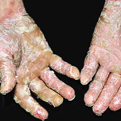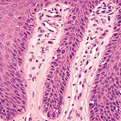Psoriasis Vulgaris
General Information
Psoriasis Vulgaris is the most common form of psoriasis affecting 80% – 90% of individuals with the disease. Red irregular to oval plaques located on the scalp, trunk and the limbs typically characterizes psoriasis vulgaris. These plaques are covered with silver scales. The cause is related to a type of white blood cell called a T lymphocyte or T cell malfunction in the immune system. Psoriasis can also be triggered by other factors including infections, trauma to skin, stress, cold weather, smoking, excessive alcohol consumption and certain medications. The goal in treatment is to interrupt the cycle causing the increased production of skin cells, to reduce inflammation and resulting new plaques formation. Other treatments help smooth the skin to help remove the scaling. Treatments recommended by healthcare providers include topical therapy, phototherapy, systemic agents, and biologic therapies.
Epidemiology
Affects 1% to 2% of the American population
Etiology
Genetic and environmental factors
Pathogenesis
Overexpression and underexpression of certain proteins; protein expression can be divided into three areas; abnormal keratinocyte differentiation, hyperproliferation of the keratinocyte, and infiltration of inflammatory elements.
Clinical
Dry, red skin lesions covered with silver scales
Histology
Neutrophils and lymphocytes can be observed migrating upwards from the dermis into the acanthotic epidermis. Neutrophils may form localized collections known as Munro microabscesses. The presence of alternating collections of neutrophils sandwiched between layers of parakeratotic stratum corneum is virtually pathognomonic for psoriasis.
Bibliography
1. “Psoriasis, Plaque” (Online). March 2007. http://www.emedicine.com/derm/topic365.htm (visited: April 2, 2008) 2. “Psoriasis” (Online). March 2007. http://www.mayoclinic.com/health/psoriasis/DS00193/DSECTION=1 (visited: April 2, 2008)
Download PDF
![]() Psoriasis Vulgaris
Psoriasis Vulgaris


